
They are rare in the wild and not so common as pets either.
As a result, a number of closely related animals are often mistaken for chinchillas.
So let’s clear up the confusion.
We are going to look closely at the different types of chinchillas, as well as their closest relatives.
Keep reading to learn which animals are actual chinchillas and how they look and act. You will also learn about the chinchilla’s two closest relatives.
Contents
Different Types Of Chinchillas
There are only two different types of chinchillas in the world. Other animals may be in the chinchilla family (see below), but they are not part of the chinchilla species. There are also a number of chinchilla-like animals.
Long-Tailed Chinchilla
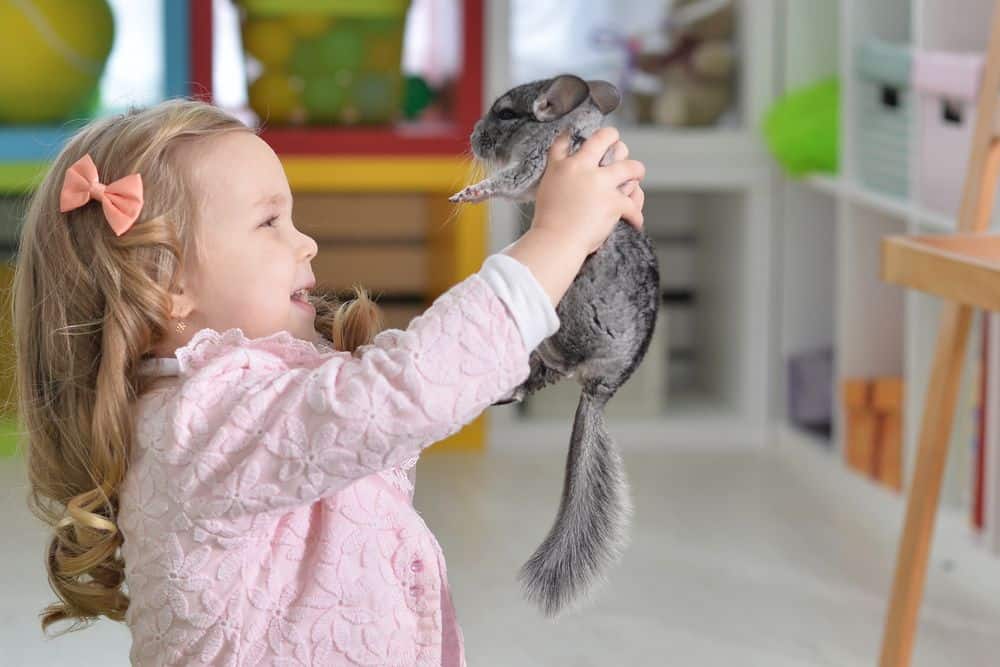
Also known as the Chinchilla lanigera or the Common Chinchilla, Coastal Chinchilla, Chilean Chinchilla, or Lesser chinchilla, the long-tailed chinchilla is an endangered species. It is hunted for its coat.
The other scientific names for the long-tailed chinchilla are Mus laniger, chinchilla velligera, Cricetus chinchilla, Lommus lanigera, and Cricetus lanigera.
Physical Description
Long-tail chinchillas are smaller in size than the other domestic chinchilla species, the short-tailed chinchilla, which we will discuss shortly. They measure up to 10 inches, or 25 cm, in length.
As their name indicates, they have a longer tail than their counterparts. In fact, the tail makes up a third of the long-tailed chinchilla’s body!
Long tails also have more rounded ears. They have fleshy foot pads and their eyes have vertical split pupils. Their hindlimbs are larger than the forelimbs and they have movable toes which help them grasp objects.
Male long tails weigh, on average, about 14 ounces or 412 grams. Females are slightly larger and heavier with an average weight of 14.9 ounces (422 g).
Breeders often breed long-tailed chinchillas in captivity. These domesticated chinchillas are larger than the ones found in the wild.
Chinchillas do not have woolen coats. Instead, they have hair that is silky and soft. Colors seen in the wild long-haired chinchilla are bluish, silvery-gray, and charcoal.
These days, breeders selectively breed chinchillas to obtain unique recessive colors like white, ebony, sapphire, and violet chinchillas. The underparts of the chinchilla’s body are yellowish-white. Grey chinchillas are the most common.
Behavior And Habitat
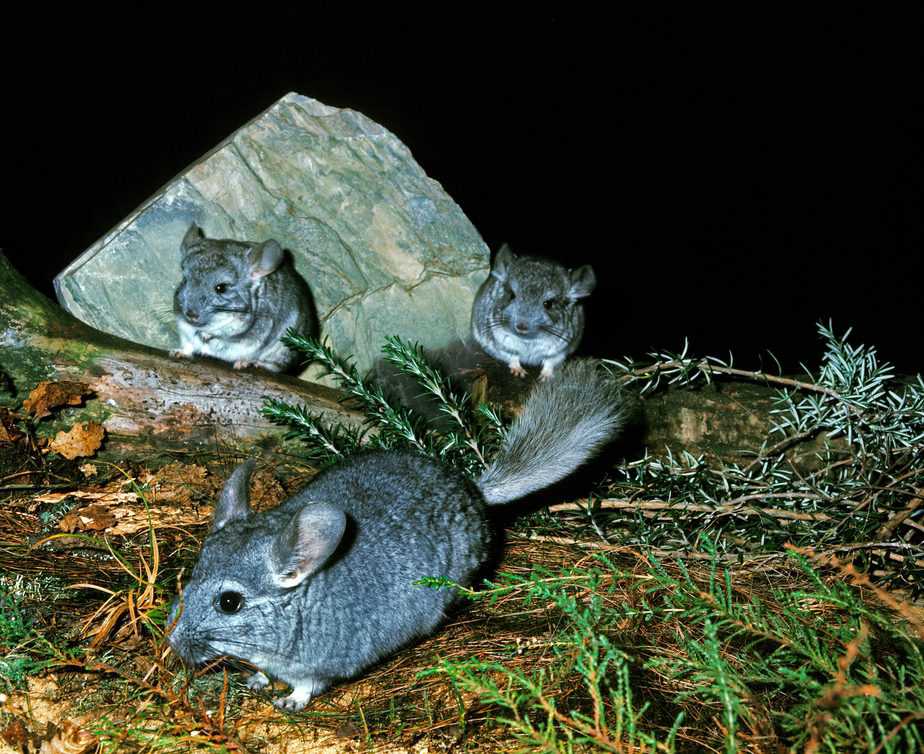
Long-tailed chins live at elevations over 3000 feet in the Andes Mountains of Chile. They prefer the harsh, arid climate found in the region.
Domesticated chinchillas also prefer cool temperatures between 65-80 F. They do not like humidity, which can impact their coat health. In summer, you need to take steps to protect your domesticated chinchillas from heat strokes, if temperatures go above 80° F or, 26.7° C.
Chinchillas are crepuscular animals meaning they are most active at dusk and dawn. They are also social and live in groups in the wild.
Diet
Wild chinchillas eat high-fiber diets. They forage on seeds, grass, hay, flowers, shrubs, etc. In captivity, you should feed them pelleted commercial chinchilla food along with a constant supply of hay.
Short-Tailed Chinchilla
The short-tailed chinchilla also goes by the name of Chinchilla chinchilla. Like its long-tailed counterpart, it is declared endangered by the IUCN. Other scientific names for the short-tail chin are Chinchilla brevicaudata and Eriomys chinchilla.
Physical Description
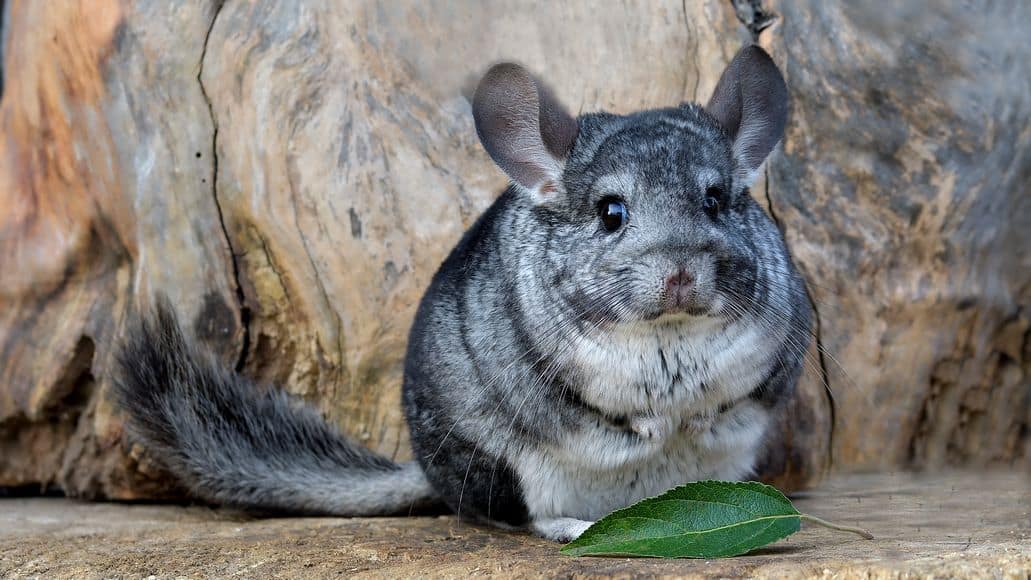
The short-tailed chinchilla is a lot heavier than the long-tailed chin. They weigh between 14 and 28 ounces (400-800 g) and measure 9 to 14 inches (23-38 cm ).
They also have thicker necks, wider shoulders, and smaller ears. Domesticated short-tailed chins measure and weigh almost twice as much as the short-tailed chins that live in the wild.
Short-tailed chins have powerful eyesight. Their large eyes with vertical split pupils help them see clearly in low-light conditions. Their large ears help them hear predators
Like their long-tailed counterparts, short-tails have a lot of soft hair on their bodies. This fur is in high demand, which is why they are hunted extensively.
The color of wild short-tailed chins is grayish blue. Breeders breed rare colors like ebony, white, sapphire, violet, beige chins, etc.
Behavior And Habitats
Short-tailed chinchillas are shy animals. They are also nocturnal and hide during the day and hunt at night. They are extremely clever animals and can navigate and forage. They are skilled at evading predators. They have to be.
Short-tailed chinchillas usually live in herds in self-dug burrows and crevices of volcanic ashy rocks of the Andes. They often roll in the dust to coat their bodies with volcanic ash.
This absorbs the oils and keeps their fur clean and free from parasites. Domesticated chinchilla owners must provide their pets with dust bowls so that they can take regular dust baths.
Diet
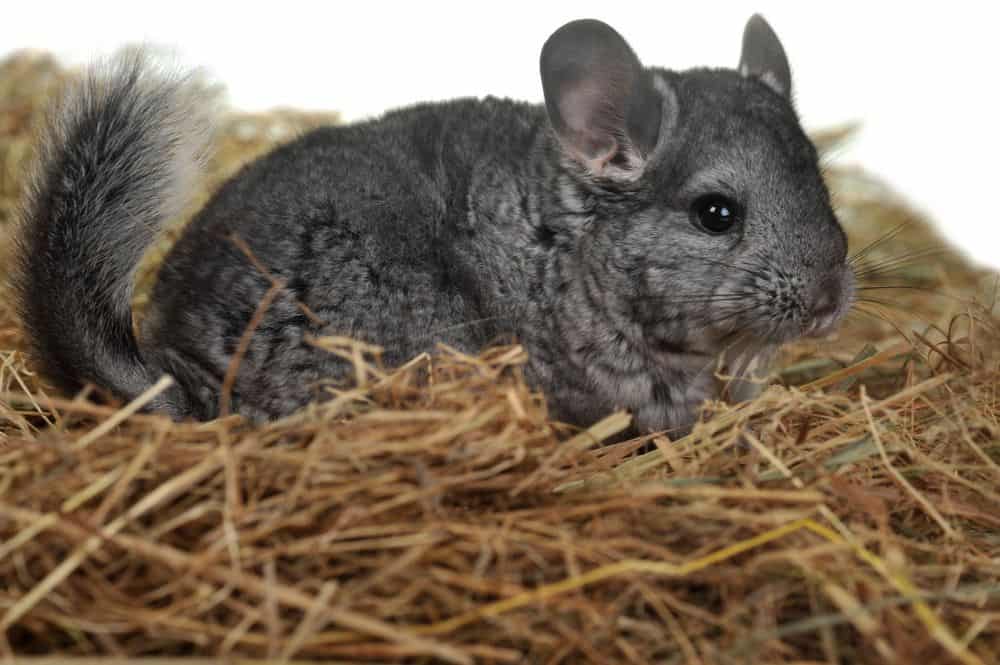
These omnivores mainly eat plant-based diets with foliage, roots, leaves, shrubs, seeds, nuts, grasses, flowers, etc. In the wild, they have to compete with goats and other cattle for food.
Domesticated chins have the tendency to overeat and pack on the pounds. As a chinchilla owner, you must take care not to feed them too much food.
Wild chinchillas are also constantly gnawing on Chilean pine needles, and pretty much everything they can find, to keep their teeth from growing too long.
The teeth never stop growing, so these animals need to chew all the time to grind them down. Make sure you provide plenty of chewable items for your pet chin.
Varieties Of Domestic Chinchillas
There are three different varieties of domestic chinchillas. These are thought to have descended from the long-tailed chinchilla. These are the three domestic breeds and the general characteristics of a chinchilla of each breed.
La Plata Chinchilla
This is the heavier and more muscular variant. They appear round and compact and have short and round ears.
Costina Chinchilla
This variant is characterized by weaker musculature. They also have long hind legs and longer ears. When viewed from the front, their head appears v-shaped. They have pointed noses.
Raton Chinchilla
This type of chinchilla also has a muscular and rounder bone structure like the La Plata, but its nose is pointed like the costina. It is also a lot smaller than the other two varieties.
Close Chinchilla Relatives
There are also a number of rodents that are close relatives of the chinchilla. They belong to the chinchilla family, but they are different species. Some people do mistake them for chinchillas, although they differ noticeably.
Viscacha
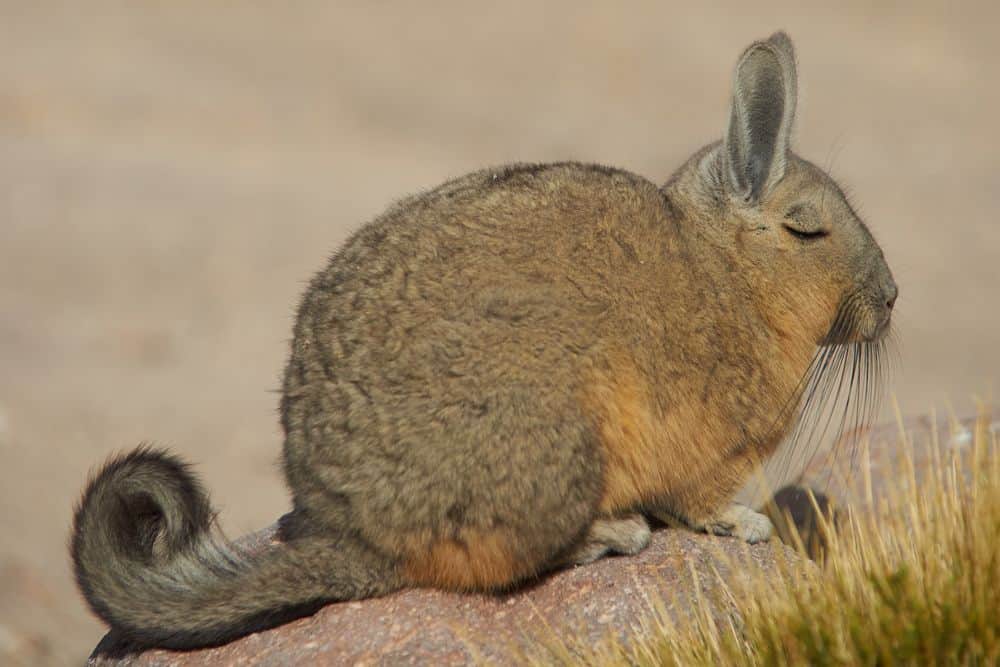
The viscacha is the closest chinchilla relative, but differs significantly from the beautiful chinchilla, whose fur is in great demand. Viscachas belong to the Chinchillidae family just like our chins. We have a full comparison of chinchillas and viscachas here.
Habitat And Description
Viscachas are found on the plains of La Plata in the Andes. They are the most common large rodents in the region. They measure between 18 inches to 2 feet, making them a lot larger than our petite chinchillas. They resemble rabbits, although they are rodents.
Viscachas are usually grey or brown in color with short, bushy tails and long, furry ears. Chins have larger ears and longer tails in proportion to to their bodies when compared to the Viscacha.
Behavior
Viscachas are clever animals. They are known to drag objects that make them curious to their burrows. This even includes lost items from travelers like whips and boots!
Diet
Viscacha cut and drag every vegetable they can get their hands on to their holes. They survive on grass, mosses, and lichens.
Degu
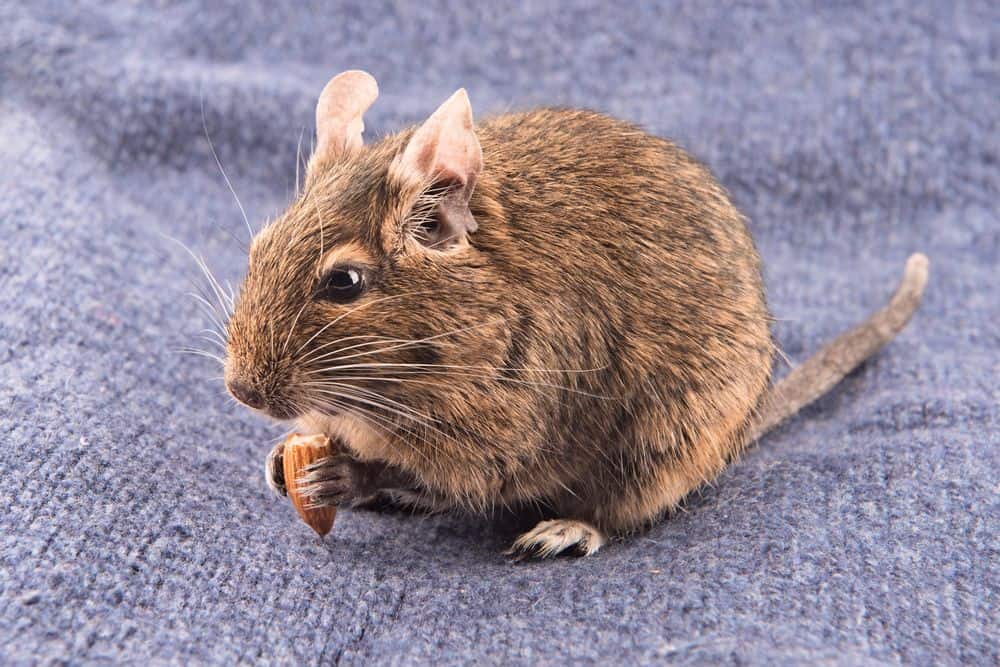
Degus may look a lot like chinchillas, but they are quite the opposite. For example, chins are mostly nocturnal (active at night) while degus are diurnal (active during the day).
Captive chins live for 15 to 20 years with good care, whereas degus only live for 6 to 8 years. See a comparison of the degu and the chinchilla here.
Habitat And Description
Degus are smart rodents native to Central Chile. The average degu weighs between 6 and 10.5 ounces (170-300 g) and measures between 10 and 12 inches. They have long, thin tails, and yellow-brown or dark coats.
Behavior
This native Chilean rodent loves to chew and chomp. They also enjoy dust baths like chinchillas. In the wild, they store food for the winter. Captive degus also hide their food for the same reasons.
These digging animals love to burrow and it keeps them active, while also providing them with space to hide and rest. Degus have a social hierarchy and they often fight with each other.
Diet
Degus eat a diet similar to chins. They need a constant supply of hay or grass. They also need commercial food pellets. In the wild, degus eat grass, green vegetation, seeds, mosses, fruits, and flowers.
Different Kinds Of Chinchillas: Related Questions

Next, we will answer a few common questions related to the chinchilla and its appearance and characteristics. If you have any additional questions, please feel free to ask them in the comments below.
What Color Chinchilla Is Rare?
Colors like gold bar, golden and silver mosaic, touch of velvet, white sapphire, white violet, and black and brown velvet are rare colors. To learn more about the different colors chinchillas come in, read this article.
What Type Of Breed Are Chinchillas?
Chinchillas belong to the Chinchillidae family of rodents and the Hystricognatha suborder.
Are Degus Chinchillas?

Degus are similar to guinea pigs and chinchillas, but they have a lot of differences when compared to chinchillas. These small burrowing rodents are diurnal and have a much shorter lifespan than the chinchilla.
How Many Species Of Chinchillas Are There?
As mentioned, there are two basic species of chinchilla. They are the long-tailed chinchilla and the short-tailed chinchilla.
Different Chinchilla Breeds: Final Thoughts
Now you know that there are only two different types of chinchillas: the long-tailed and the short-tailed chinchilla. In addition, there are three types of domesticated chinchillas that are thought to have come from the long-tailed variety.
There are also a few other animals in the chinchilla family. They are quite different in appearance and characteristics, but many people do mix them up. Especially the degu, which does look fairly similar.
Leave a Reply